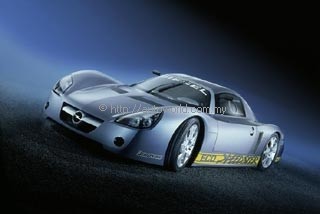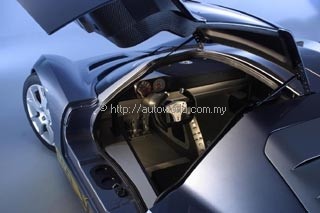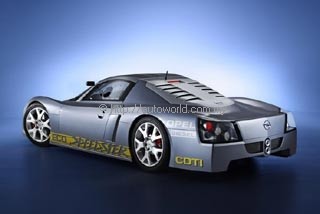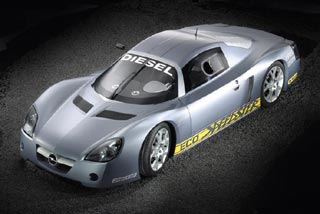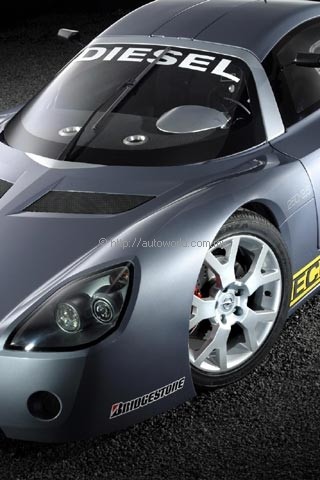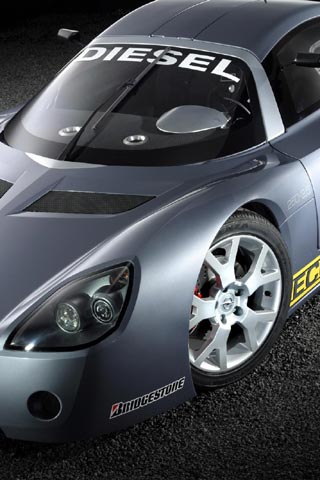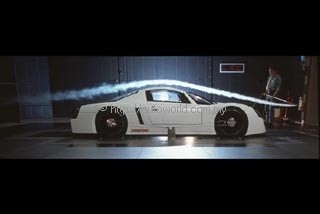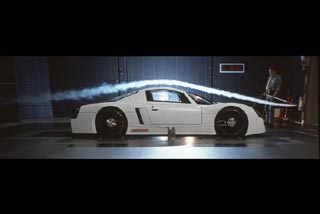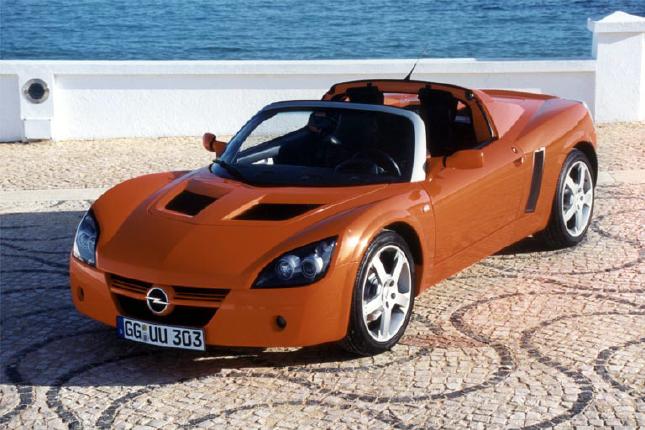Eco-Speedster Shows Opel’s Future
In developing the Eco-Speedster technology concept sportscar, Opel is impressively demonstrating the potential that exists in a combination of advanced driveline technology, sophisticated aerodynamics and systematic weight-saving construction.
The world premiere of this spectacular prototype at the Paris Auto Salon marks the start of the biggest diesel campaign in Opel’s history. By the end of 2003, the company will introduce four all-new common rail diesel engines across the range, with power outputs of up to 130 kW (177 bhp).
The highly efficient Eco-Speedster prototype with its spectacular long-tail body demonstrates impressively the performance potential of the future 1.3 CDTI ECOTEC engine: during initial testing, the 82 kW/112 bhp concept car reached a maximum speed of over 250 km/h, while fuel consumption according to the MVEG cycle was a miserly 40 kms/litre (113 mpg).
The two-seat prototype is based on the mid-engined Speedster roadster (produced by Lotus for Opel), but with a new, carbon fibre bodywork that has much improved aerodynamics. With significantly reduced drag (0.20 Cd) and even lower weight (around 660 kgs), the Eco-Speedster takes up where another Opel prototype left off 30 years ago.
On June 1, 1972, at the company’s proving ground, a modified Opel GT with a 70 kW/95 bhp, 2.1-litre turbocharged diesel engine made the headlines by setting several world records for diesel passenger cars and reached a top speed of 197.5 km/h. Shortly afterwards, Opel launched the Opel Rekord 2.1 D, its first diesel-engined passenger car.
The new Eco-Speedster is proof of the progress made in the last 30 years and of the diesel engine’s amazing passenger-car career. When the record-breaking GT made its sensational appearance, it was the first time that “sportscar performance” had been associated with the diesel engine. The all-new ECOTEC-CDTI diesel, with the latest multi-jet common rail fuel injection, four valves per cylinder and variable-geometry turbocharger, has a displacement of only 1.3 litres.
This innovative engine is notable for its compact dimensions (length x width x height: 460x500x650 mm). In terms of fuel consumption, emissions and refinement, it proves to be one of the best diesels of all. Compared with other current engines of similar output, fuel consumption will be down by approximately 10% and emissions will be cut by 30 to 40% and thus outperform the Euro 4 limits. At 1251 cc, this ECOTEC unit is the world’s smallest 4-cylinder diesel, but with regard to output and torque it can compete with substantially larger engines.
The basis for this performance potential is the ultramodern design of the new CDTI ECOTEC engine. An alloy cylinder head tops the weight-optimized cast-iron engine block with a long stroke of 82 mm. There are four valves per cylinder, operated by roller cam followers from two chain-driven overhead camshafts. The latest multi-jet direct injection system with fuel supply by ‘common rail’ at a pressure of 1600 bar is another noteworthy feature.
Fuel supply to the five-hole nozzles is controlled via an ultramodern solenoid valve. The fuel injection system’s response time is less than 20 millionths of a second, ensuring extremely fine metering of the fuel and up to five injections per working cycle. This not only keeps fuel consumption and exhaust emissions extremely low, but also ensures smooth, low-noise operation. Pilot injection helps to reduce the once notorious diesel-engine knock in the warm-up phase to a hardly identifiable level.
Whereas the diesel engine is of completely new design, the advanced engineering team at Opel’s International Technical Development Center was able to make use of a tried-and-tested basis for the car itself.
“The Speedster was nevertheless subjected to some fundamental modifications,” explains Walter Treser, head of Opel’s Advance Engineering department. “In order to achieve our own target of over 250 km/h top speed and a standard test consumption of only 40 kms/litre, considerable improvements in aerodynamics and weight were essential.” By facing this challenge, the engineers had an opportunity to demonstrate the limits of feasibility in this area.
Calculations soon showed that the target performance figures could only be achieved by reducing the drag coefficient by half – definitely a highly ambitious goal. And in due course it became clear: this target could not be achieved by pure optimization; more radical steps would have to be introduced.
The first step was to reduce the Speedster’s frontal area. The engineers lowered the now rigid roof of this already low-slung sports car by another 167 mm and gave the car a more steeply raked windshield. This put the Eco-Speedster’s height at a mere 950 mm, which would make it almost impossible to enter and leave through standard doors. The design study was therefore fitted with gullwing doors.
An extremely small detachable steering wheel also helps to make entering the car more convenient and gives the driver more room. The backs of the carbon-fibre reinforced racing seats were also given a more inclined position. Since occupant comfort was not yet one of the main priorities, the cockpit was also reduced in width above the waistline.
All these modifications to the standard Speedster results in a frontal area (in technology identified with the letter A), of only 1.4 m2 – 12.5% less than the production Speedster.
On this basis and according to the motto “length means speed”, the next task was reducing the drag coefficient. The most striking novelty is the long tail. It extends 184 mm farther back, so that the airflow clings closer to the body and generates less turbulence.
The impression of extra length is enhanced by the panels above the mid-engine; looking at the car from the side, there is a continuous gently sloping line from the windshield frame to the tail panel. Further visual clues to the excellent aerodynamics are the almost complete paneling of the rear wheel cutouts and the smooth front wheel covers. In wind tunnel tests, final detailing led to the results calculated by the design computer in advance: With a Cd of 0.20 and an overall aerodynamic drag (Cd x A) of 0.28 sq m, the Eco-Speedster’s shape is 47% more slippery through the air than its production counterpart.
“With its long tail and the pronounced cockpit dome including the gull-wing doors, the design study reminds me of the classic long-distance cars of the 1960s. We succeeded in maintaining the characteristic edges of the Speedster as well as typical elements such as headlamps and tail lights and the trapezoidal front-end styling. The Eco-Speedster is not in the least nostalgic, however: it looks like an Opel and is recognized as one at first glance,” said Stefan Arndt, designer of the Eco-Speedster, who is not only happy about the technical results obtained by the modifications:
What can’t be seen under the elegant light-silver competition-car finish – but shows up on the scales: all elements of the body’s outer skin are made of carbon fibre. Based on the Speedster’s light, rigid aluminium frame, the weight of the prototype has been reduced to 660 kgs. Further factors such as particularly low-resistance size 175/55 R 17 W tyres and special low-friction engine oil complete the Eco package for the Speedster.
Explaining the prototype’s background, Opel’s CEO Carl-Peter Forster said: “The Eco-Speedster symbolizes our comprehensive diesel offensive and at the same time demonstrates Opel’s engineering expertise in powertrains, weight-saving design and aerodynamics. By the end of 2003, we will have introduced four new, state-of-the-art common rail diesel engines with a wide range of power outputs, low weight and moderate fuel consumption.”




